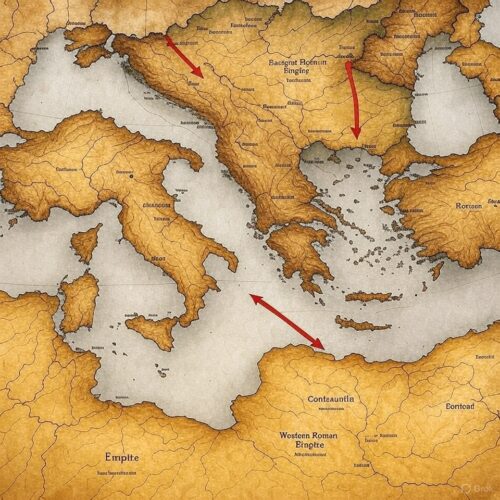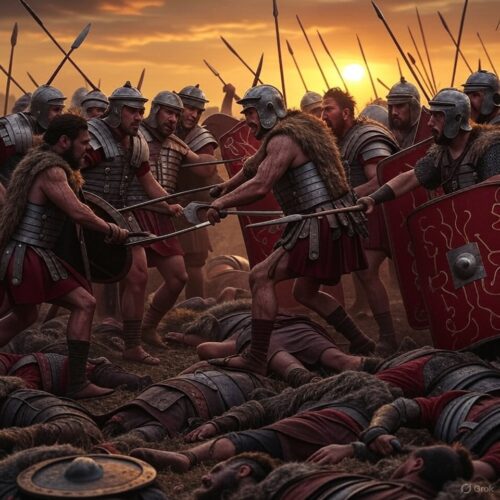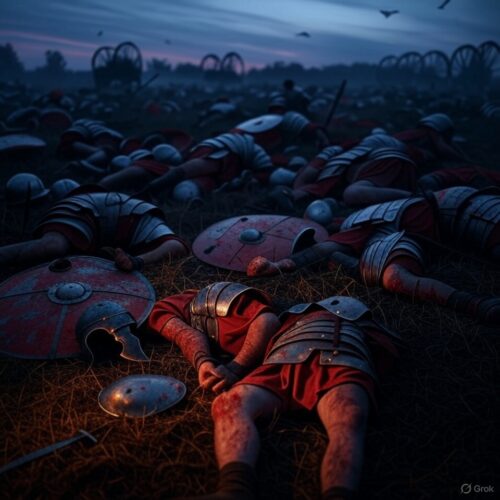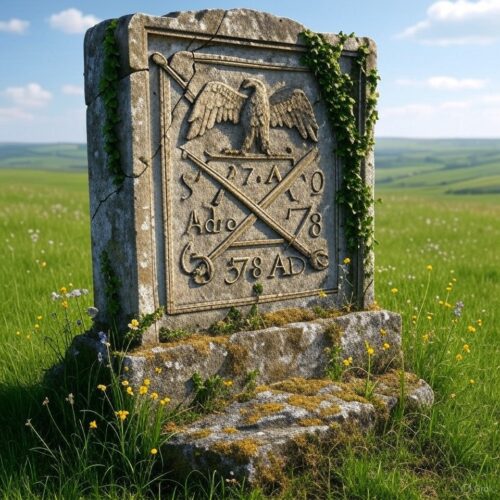Welcome, history buffs and life hackers alike! Imagine a sweltering summer day in the late 4th century AD, where the fate of one of the world’s greatest empires hung by a thread amid dust-choked plains and the clash of steel. On August 9, 378 AD, the Battle of Adrianople unfolded like a tragic epic, pitting the mighty Eastern Roman Empire against a desperate coalition of Gothic warriors. This wasn’t just a skirmish; it was a seismic shift that rattled the foundations of Rome and echoed through centuries. In this deep-dive blog, we’ll unpack the intricate historical tapestry of this pivotal event—far more history than pep talk, as promised—before drawing out motivational gems you can apply to your own life. Buckle up for a journey through time that’s informative, educational, fun, and yes, highly motivational. Let’s dive in!
#### The Roman Empire in the Late 4th Century: A Colossus on Shaky Ground
To truly grasp the Battle of Adrianople, we must first set the stage with the broader context of the Roman Empire during this era. By the late 4th century, Rome was no longer the monolithic powerhouse of Augustus or Trajan’s time. The empire had been divided since 285 AD under Diocletian into Eastern and Western halves to better manage its vast territories stretching from Britain to Mesopotamia. The Eastern Roman Empire, ruled from Constantinople (modern Istanbul), was wealthier and more urbanized, boasting thriving cities like Antioch, Alexandria, and Adrianople itself.
Emperor Valens, who reigned from 364 to 378 AD, was a key figure in this narrative. Born around 328 AD in Cibalae (modern Vinkovci, Croatia), Valens was the younger brother of Valentinian I, the Western Emperor. Appointed co-emperor in 364 AD, Valens inherited the Eastern throne at a turbulent time. He was a devout Arian Christian, which put him at odds with the Nicene orthodoxy favored by many in his realm, leading to religious tensions that simmered beneath the surface. Valens was known for his administrative reforms, including aqueduct construction in Constantinople and efforts to fortify borders, but he was also criticized by contemporaries like the historian Ammianus Marcellinus for his harshness and impulsiveness.
The empire faced external pressures from all sides. To the east, the Sassanid Persians under Shapur II posed a constant threat, forcing Valens to campaign there in the early 370s. But the real storm brewed in the north: the migration of barbarian peoples driven by the Hunnic invasions. The Huns, a nomadic warrior confederation from the Central Asian steppes, began pushing westward in the mid-370s, displacing tribes like the Alans, Greuthungi (Ostrogoths), and Tervingi (Visigoths). This “Great Migration” or Völkerwanderung was a chain reaction of displacement, hunger, and desperation that would forever alter Europe’s map.
In 376 AD, the Tervingi Goths, led by Fritigern and Alavivus, appeared on the Danube River’s northern bank, pleading for asylum within Roman borders. Fleeing the Huns, they offered to settle as foederati—allied troops—in exchange for land and food. Valens, seeing an opportunity to bolster his armies depleted by Persian wars, granted permission. However, corruption among Roman officials like Lupicinus and Maximus turned this into a humanitarian disaster. The Goths were exploited, starved, and sold into slavery, sparking revolts. By 377 AD, open warfare erupted. Initial Roman forces under Lupicinus were crushed near Marcianople (modern Devnya, Bulgaria), allowing the Goths to ravage Thrace.
Valens, returning from Persia, sought reinforcements from his nephew Gratian, the young Western Emperor. Gratian had recently won victories against the Alemanni on the Rhine but was delayed. Meanwhile, the Goths swelled their ranks with escaped slaves, disgruntled miners from Roman gold mines, and even deserters from the Roman army. Fritigern, a shrewd leader who had converted to Arian Christianity (possibly to align with Valens), emerged as the primary Gothic commander. He employed guerrilla tactics, avoiding pitched battles while plundering the countryside.
By summer 378 AD, Valens established a base in Constantinople and marched northwest to Adrianople, a strategic city about 140 miles west. Adrianople (Hadrianopolis) was founded by Emperor Hadrian in the 2nd century AD and served as a key junction on the Via Egnatia, linking the Balkans to Asia Minor. Its walls were formidable, but the battle would occur outside them on open plains.

#### The Lead-Up to Battle: Miscalculations and Marching Orders
As August 378 dawned, tensions peaked. Valens’ scouts reported the Gothic camp about 8-12 miles north of Adrianople, near the Hebrus River (modern Maritsa). The Goths had formed a laager—a defensive wagon circle—protecting their families and loot. Estimates of forces vary: Ammianus Marcellinus, our primary source (a retired Roman soldier who wrote the Res Gestae around 390 AD), suggests the Romans had around 15,000-20,000 men, including elite units like the Scholae Palatinae (imperial guards), legions such as the Lanciarii and Mattiarii, and auxiliary cavalry. The Goths, including Visigoths, Ostrogoths under Alatheus and Saphrax, and Alans, numbered similarly, perhaps 12,000-20,000 warriors, but with superior cavalry.
Valens arrived at Adrianople on August 6, encamping outside the city. He debated waiting for Gratian’s 10,000-15,000 reinforcements, who were en route but slowed by Alamannic raids. Court advisors were split: Sebastianus, a capable general recently arrived from the West, urged caution, while others like Victor (a Sarmatian-born magister equitum) advocated attack, underestimating Gothic numbers based on faulty intelligence claiming only 10,000 foes.
On August 7, Fritigern sent envoys proposing peace, offering loyalty if granted land in Thrace. Valens dismissed this, suspecting a ploy to buy time for Gothic cavalry foraging afar. Indeed, much of the Gothic horse was absent, scouting for supplies. Valens, eager for glory to match Gratian’s recent triumphs, decided to strike on August 9 without waiting.
The Roman march began at dawn under a blistering sun—temperatures soared, exhausting troops in heavy armor. They covered about 12 miles by early afternoon, arriving within sight of the Gothic wagon circle on a gentle hill. The Goths, alerted, prepared defenses, chanting war songs and beating shields. Fritigern stalled again, sending a Christian priest as envoy with secret letters urging negotiation, aiming to delay until his cavalry returned.
Valens arrayed his forces: infantry in the center, cavalry on flanks. The right wing, under generals like Traianus and Sebastianus, advanced first, engaging Gothic skirmishers. Archers exchanged volleys, but discipline held.

#### The Battle Unfolds: Chaos, Cavalry, and Catastrophe
Around 2 PM, as negotiations dragged, Roman troops—thirsty and fatigued—grew restless. A skirmish on the right flank escalated when Roman cavalry charged prematurely, igniting full battle. The Gothic infantry, armed with spears, swords, and shields, formed a dense phalanx behind wagons.
The turning point came with the unexpected return of Gothic cavalry—Ostrogoths and Alans—thundering from the hills. Led by Alatheus and Saphrax, they smashed into the Roman left flank, which had advanced too far and was exposed. Roman cavalry on the left routed, exposing infantry to encirclement.
The Roman center pressed forward, clashing with Gothic foot soldiers in brutal hand-to-hand combat. Dust clouds obscured vision, arrows darkened the sky, and the din of screams and clashing metal filled the air. Elite Roman legions like the Batavi and Heruli fought valiantly, but the Gothic horse wheeled around, hammering the Roman rear.
Valens, positioned in the rear with reserves, watched in horror as his lines buckled. Attempts to rally failed; the emperor himself was wounded by an arrow. According to Ammianus, Valens fled to a nearby cottage, where Goths set it ablaze, unaware of his presence—his body was never found, fueling legends.
By dusk, the field was a slaughterhouse. Two-thirds of the Roman army perished—10,000-15,000 dead, including 35 tribunes and generals like Sebastianus and Equitius. Gothic losses were lighter, though significant.
Ammianus compared it to Cannae (216 BC), where Hannibal annihilated Romans. This defeat stripped the East of its field army, forcing reliance on mercenaries and accelerating barbarization of the military.

#### Aftermath and Long-Term Ripples: From Defeat to Decline
The immediate aftermath was grim. Surviving Romans retreated to Adrianople, but Goths besieged the city unsuccessfully. Fritigern’s forces ravaged Thrace, but lacked siege expertise to take major cities.
Gratian appointed Theodosius I as Eastern co-emperor in 379 AD. A skilled Spaniard, Theodosius rebuilt the army with barbarian recruits, negotiating peace in 382 AD. Goths settled as foederati in Moesia, retaining autonomy—a precedent for future invasions.
Adrianople marked a psychological blow. It exposed Roman vulnerabilities: overreliance on infantry against mobile cavalry, corruption in administration, and imperial hubris. Historians like Edward Gibbon in “The Decline and Fall of the Roman Empire” (1776) saw it as a harbinger of Rome’s fall, though modern scholars like Peter Heather argue it accelerated existing trends rather than causing them outright.
The battle influenced military tactics; Romans increasingly adopted cavalry-heavy forces, foreshadowing Byzantine cataphracts. It also shifted power dynamics, emboldening barbarians like the Vandals and Suebi, who crossed the Rhine in 406 AD, leading to the Western Empire’s collapse in 476 AD.
Religiously, Valens’ Arianism died with him; Theodosius enforced Nicene Christianity in 380 AD via the Edict of Thessalonica, shaping medieval Europe.
Economically, the loss disrupted Balkan mining and agriculture, straining the treasury. Culturally, it inspired literature; Ammianus’ vivid account remains a cornerstone of late antique history, blending eyewitness reports with dramatic flair.
Adrianople’s legacy endures in military studies. It’s taught in academies as a cautionary tale of intelligence failures and hasty decisions. Archaeological evidence is scarce— the battlefield isn’t precisely located—but coins and weapons from Edirne museums hint at the era’s turmoil.

#### Echoes in Eternity: Broader Historical Context and Analyses
Delving deeper, let’s explore the Gothic society that challenged Rome. The Visigoths, descendants of Baltic tribes, had evolved into a warrior aristocracy by the 4th century. Fritigern, possibly of noble birth, exemplified adaptive leadership, blending Roman diplomacy with tribal ferocity. The Goths’ aurochs-horn helmets and long swords were no match for Roman discipline in theory, but mobility won the day.
Roman army evolution is crucial too. Post-Constantine (306-337 AD), the legions shifted from citizen-soldiers to professional, often barbarian, forces. Valens’ troops included Armenians, Iberians, and Arabs, reflecting diversity but also loyalty issues.
Comparative history: Adrianople parallels Teutoburg Forest (9 AD), where Germans ambushed Romans, or Carrhae (53 BC) against Parthian cavalry. Yet, its scale—losing an emperor in battle—was rare since Decius’ death in 251 AD.
Modern interpretations vary. Some, like Alessandro Barbero in “The Day of the Barbarians” (2005), emphasize climatic factors; drought may have exacerbated migrations. Others, like Guy Halsall, downplay it as “the beginning of the end,” noting Rome’s resilience until 410 AD’s sack.
Numismatics offer insights: Valens’ coins depict him as “Restitutor Reipublicae” (Restorer of the Republic), ironic given his fate. Gothic artifacts from Romanian sites show cultural fusion post-battle.
In literature, Eunapius and Zosimus provide supplementary accounts, criticizing Valens’ arrogance. Byzantine chroniclers like Jordanes in “Getica” (551 AD) romanticize Gothic heroism, tracing their kings to this victory.
Geopolitically, it weakened Rome against Huns; Attila’s invasions in the 440s exploited this vacuum. Ultimately, Adrianople symbolized the transition from classical antiquity to the Middle Ages, where feudalism and barbarian kingdoms rose from Roman ruins.

#### From Ancient Plains to Modern Gains: Applying Adrianople’s Lessons Today
Now, let’s pivot to the fun, motivational side—how can this ancient debacle fuel your success? The Battle of Adrianople teaches us about preparation, patience, and adaptability. Valens’ rush without allies led to ruin; Fritigern’s cunning prevailed. Here’s how you benefit by applying these to your individual life:
– **Cultivate Patience in Decision-Making**: Valens attacked prematurely; today, avoid impulsive career moves like quitting without a backup plan. Benefit: Reduces regret, allowing time for better opportunities to emerge.
– **Build Strong Alliances**: Waiting for Gratian could have turned the tide. In life, network with mentors or colleagues before big projects. Benefit: Shared resources and insights amplify your strengths, turning potential failures into wins.
– **Gather Accurate Intelligence**: Faulty scouts doomed Rome. Research thoroughly before investments or relationships. Benefit: Minimizes risks, leading to informed choices that save time and money.
– **Adapt to Unexpected Challenges**: Gothic cavalry’s surprise return was decisive. Develop flexibility in routines, like pivoting during job loss. Benefit: Builds resilience, turning setbacks into growth stories.
– **Learn from Hubris**: Valens sought solo glory. Stay humble, seek feedback regularly. Benefit: Fosters continuous improvement, enhancing personal and professional relationships.
To implement, follow this specific plan:
- **Week 1: Reflect and Research** – Journal past impulsive decisions, research one current challenge (e.g., via books or experts).
- **Week 2: Network and Ally** – Reach out to three people for advice; schedule meetings.
- **Week 3: Practice Patience** – Delay non-urgent decisions by 24 hours; note outcomes.
- **Week 4: Adapt and Review** – Try a new skill or hobby; review what worked, adjust.
- **Ongoing: Humility Check** – Monthly, ask for constructive criticism from trusted sources.
Repeat and refine—this plan turns historical wisdom into daily victories. You’re not just surviving; you’re conquering like a modern Fritigern!

